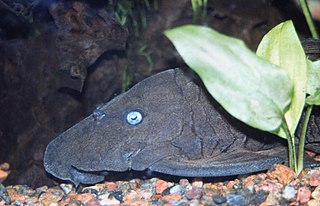
The blue-eyed plec is a herbivorous freshwater armored catfish endemic to Colombia where it occurs in the Cauca and Magdalena River basins. It is distinguished from many loricariids by being dark grey to black and having bright, turquoise-coloured eyes. Like other species of the genus Panaque, P. cochliodon feeds primarily on submerged wood. Blue-eyed plecs grow to about 30 cm in length and, like other Panaque species, they are clumsy swimmers adapted to staying close the substrate, using their sucker-like mouths to hold on to submerged rocks and wood.

Pterygoplichthys joselimaianus, also known as the Gold spot pleco or the Marbled sailfin pleco, is a species of armored catfish. It is endemic to Brazil, occurring in the Tocantins River basin. It is often mistaken for Pterygoplichthys pardalis or Pterygoplichthys gibbiceps.
Aposturisoma myriodon is a species of armored catfish. It is the only species in the genus Aposturisoma.

The bayad, is a species of bagrid catfish from Africa.
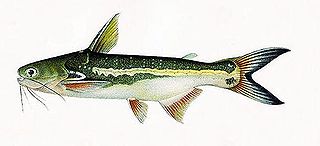
Trachelyopterus is a genus of driftwood catfishes. They have been found in South American environments, including Venezuela, Colombia, Peru, Argentina, and several places in Brazil. They have a body pattern that follows bilateral symmetry and reproduce sexually. In terms of sensory systems, Trachelypterus’ have autoliths for hearing and lens eyes for seeing; they also have capabilities of electroreception. The size and appearance of different species within the Trachelyopterus genus varies, with sizes ranging from 5.5 inches in T. albicrux to 7.9 inches in T. insignis to 8.4 inches in T. lucenai. These small catfishes are marketed towards aquariums.
Synodontis contractus, the bugeye squeaker, is a species of upside-down catfish native to the Congo Basin of the Democratic Republic of the Congo and the Republic of the Congo. This species can be found in the aquarium trade.

Silurus asotus, commonly called the Amur catfish, Japanese common catfish, Far Eastern catfish, and Chinese catfish, is a carnivorous catfish species belonging to the Siluridae family. It lives in widespread distribution in freshwater habitats across East Asia and has a high aquaculture. As a freshwater species, it can be found only in the catchments of rivers, ponds, and lakes located in China, Japan, the Korean Peninsula, Taiwan, the Russian Amur Basin and northen Vietnam.

Baryancistrus xanthellus is a species of armored catfish endemic to Brazil. It is a benthic fresh water fish that lives in the Volta Grande and Xingu River, as well as the area immediately above Belo Monte falls and the Iriri River. It reaches a length of 22.4 centimetres (8.8 in) SL. It appears in the aquarium trade, where it is typically referred to either by its associated L-numbers, which are L018, L081, L085, L177, LDA60, LDA116 or LDA117; or as the gold nugget pleco.
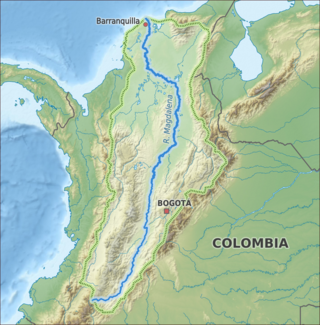
Trachelyopterus insignis is a species of catfish from the freshwater driftwood catfish family, Auchenipteridae. It is commonly found in rivers of northern South America, where it is called the chivo, the rengue, or the doncella.
Peckoltia oligospila is a species of catfish in the family Loricariidae. It is a freshwater fish native to South America, where it occurs in the lower Amazon River basin in Brazil. The species reaches 10.5 cm (4.1 in) SL. It appears in the aquarium trade, where it is typically referred to either by its associated L-number, which is L-006, or as the brown-dot peckoltia.

Hypostomus hermanni, sometimes known as Hermann's pleco, is a species of catfish in the family Loricariidae. It is native to South America, where it occurs in the Tietê River basin, including the Piracicaba River, in Brazil. It is typically found in areas with flowing water of shallow to moderately shallow depth. The species reaches 24 cm (9.4 in) in total length and is believed to be a facultative air-breather.

Hypostomus regani is a species of catfish in the family Loricariidae. It is native to South America, where it occurs in the basins of the Paraná River, the Paraguay River, and the Uruguay River. The species reaches 41 cm (16 in) SL and is believed to be a facultative air-breather.
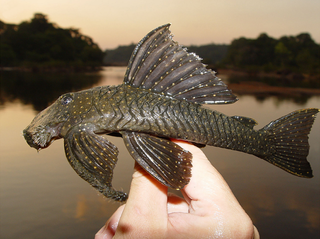
Guyanancistrus niger is a species of catfish in the family Loricariidae that is of disputed classification. It is native to South America, where it occurs in the Oyapock basin in French Guiana. Though reportedly uncommon, it is typically seen in rapids where the species Pseudancistrus barbatus is also present, although the ecological relationship between the two is not known. The species reaches 15.9 cm (6.3 in) in standard length, although it has been reported to reach 25.4 cm, and it may be a facultative air-breather.
Loricariichthys chanjoo, one of a number of Loricariichthys species commonly known as Shitari, is a species of catfish in the family Loricariidae. It is endemic to Peru, where it occurs in the Ucayali River basin, with its type locality being listed as Contamana. The species reaches 23 centimetres (9.1 in) in length and is believed to be a facultative air-breather.
Pterocryptis taytayensis is a species of catfish found in Palawan, Philippines.
Pterocryptis barakensis, is a species of catfish found in the Barak River of the Brahmaputra River basin in India.
Pterocryptis wynaadensis, also known as Malabar Silurus, is a species of catfish found in Asia in the Cauvery drainage in Kerala and Thungabadhra drainage in Karnataka, India. This species reaches a length of 30.0 cm (11.8 in).
Pterocryptis gangelica is a species of catfish found in the Ganges River, where it occurs in India and Bangladesh.
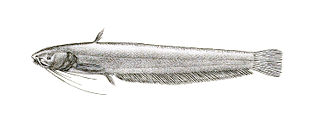
Pterocryptis cochinchinensis is a species of catfish found in the Nam Xam basin in Laos, Vietnam, south-eastern China, and Thailand.
Pterocryptis indicus is a species of catfish found in the Namdapha River in Arunachal Pradesh, India.












